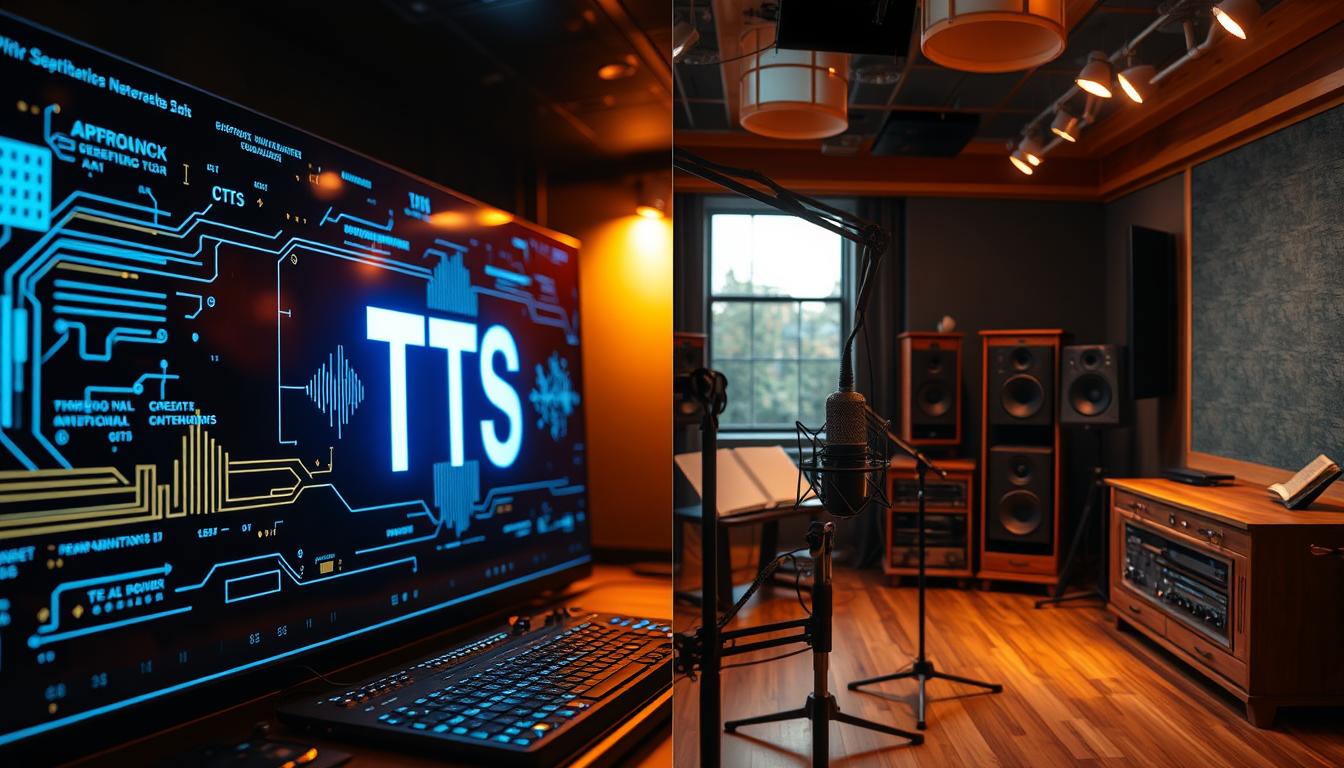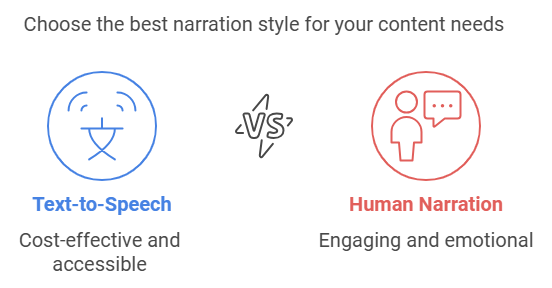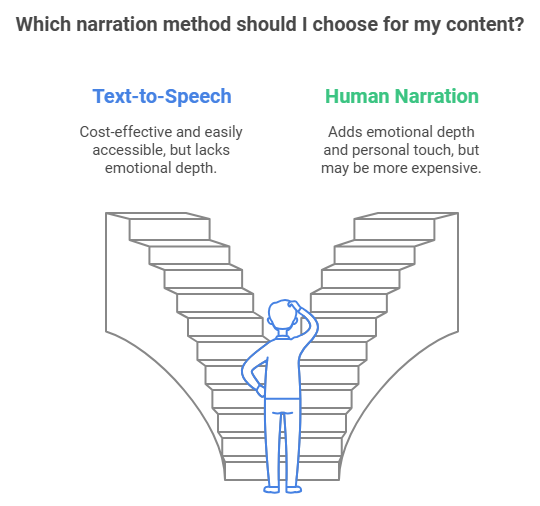
TTS vs human voices – which one’s right for your project? Here’s a straight-up look at what works best when it comes to AI and human voices.
In the world of content creation, picking between text-to-speech (TTS) and human voicesV is key. TTS started in 1939 and has grown a lot. It’s good for many things. But, human narration adds a personal touch that grabs people’s attention.
Choosing depends on what you need, how much you can spend, and who you’re talking to. TTS is cheap, easy to find, and works well. But, human narration adds feelings, passion, and understanding that listeners love.
Each has its good points and bad. Knowing these helps you pick the right one for your voice tech needs.
Key Takeaways (TTS vs human voices)
- Text to speech (TTS) technology offers affordability, availability, and accuracy, while human narration provides a personalized, emotional connection with audiences.
- The choice between TTS and human narration depends on factors like project requirements, budget, and target audience preferences.
- Both TTS and human narration have their own pros and cons, and understanding the nuances of each is essential in the evolving field of voice technology.
- TTS technology has come a long way from its 1939 start, with many uses and benefits for creators.
- Human narration adds a special charm, bringing emotions, passion, and understanding that listeners enjoy.
Understanding the Evolution of Voice Technology in Content Creation
The journey of voice technology is truly amazing. It started with Bell Labs in 1939 and now we have AI-driven systems. Text-to-speech (TTS) technology is a big step forward. John L. Kelly’s “vocoder” in 1962 was a big hit, showing us what voice synthesis could do.
The History of Text-to-Speech Development
Voice synthesis has grown and is now used in many fields. It’s in education and entertainment. Human voice acting in digital media has also changed things. It brings emotions to audiobooks, video games, and animated films.
The Rise of Human Voice Acting in Digital Media
Today, voice technology is changing fast. AI, natural language processing, and machine learning are making big changes. Now, we have many options for making content better. From simple TTS to AI voices and human narration, there’s a lot to choose from.
Current State of Voice Technology
Voice technology has changed how we make and enjoy content. Now, creators can pick the best way to make their content. Whether it’s TTS for cost and scale or human narration for emotion, there’s a lot to choose from. The future looks bright for voice technology in content.
The Core Benefits of Human Narration
Human voice acting adds a special touch to content that text-to-speech can’t match. Voice actors have the skills and experience to make digital media stand out. They bring a personal touch that makes content more relatable and engaging.
Human narration is great at showing complex emotions and subtle feelings. It’s perfect for audiobooks and marketing, where a strong emotional connection is key. This is something TTS technology can’t do as well.
- Voice actors bring a human touch to content, fostering deeper engagement and connection with the listener.
- Human narration allows for nuanced emotional delivery, capturing the full range of human expression.
- Voice actors can adapt their performance to match the tone and intent of the content, enriching the overall experience.
While human narration takes more time and money than TTS, it’s worth it. It leads to better listener retention and a more polished product. The choice between human narration and TTS depends on the project’s needs and desired emotional impact.
“The human voice is the most powerful instrument of all.” – Brené Brown
As technology advances, human voice acting remains essential in audiobook production, marketing, and more. Voice actors offer emotional depth, understanding, and personalization that’s unmatched. They are a key asset in the digital media world.
Exploring the Advantages of TTS Technology
In the world of content making, AI voices and speech synthesis are getting more popular. Text-to-Speech (TTS) tech has many benefits. It’s good for saving money, making lots of audio fast, and keeping quality the same.
Cost-Effectiveness and Scalability
TTS tech is cheap, which is great for big projects. It’s cheaper than using real voice actors. It also makes making audio fast and easy, fitting well with project needs.
Consistency and Availability
TTS tech keeps the voice the same in all content. This makes listening smooth for everyone. It’s also always ready to go, 24/7, so you can make audio anytime.
Quick Production Turnaround
For fast content like news or social media, TTS is a big help. It makes making audio fast, so you can keep up with news quickly. This is key in today’s fast world.
Even though TTS isn’t as good as real voices yet, it’s getting better. Tools like Murf and Lovo use AI to make voices sound natural. They let you choose how the voice sounds, meeting different needs.
“TTS technology is often more affordable than hiring human readers, making it a cost-effective solution, even for ongoing needs.”
The need for audio that’s easy to make, sounds the same, and is quick is growing. TTS tech is key for this. It’s cheap, always ready, and fast, making it important for the future of making audio.
Quality Comparison: TTS vs. Human Voices
The debate between text-to-speech (TTS) and human narration is ongoing. TTS is consistent and cost-effective. But human narration is better at emotions, nuances, and complex cues.
But, AI advancements have changed things. Now, some TTS voices are hard to tell from real people. This is true for news and info content.
- Voice quality: Human narration is better at emotions and natural sounds. But TTS is getting closer.
- User experience: People might like human narration more. But good TTS can be very engaging.
- Audio fidelity: Voice actors in studios can offer top-notch sound. But TTS is getting clearer and crisper.
- Narration performance: Humans are great at complex stories. But TTS is getting better at mood and tone.
“The use of professional voice-over artists is emphasized for e-Learning projects for their ability to provide high-quality audio, consistent pacing, and a professional studio environment.”
As tech keeps improving, the choice between TTS and human narration will depend on project needs. Creators should think about what’s best for their audience.

Cost Analysis and Budget Considerations
Choosing between text-to-speech (TTS) and human narration affects your budget. It’s important to know the costs of each option. This helps you make a choice that fits your budget for audio production.
Human Voice Actor Pricing Models
Getting a professional voice actor can cost a lot. Prices range from $749 for a 750-word article to $1,000-$15,000 per podcast episode. Costs depend on the actor’s experience, content length, and complexity, and how many times you need changes.
TTS Platform Subscription Costs
TTS solutions like BeyondWords are cheaper. They start at free for 30,000 characters a month. Prices go up to about $0.23 per 750 words on higher plans. This makes TTS a good choice for making lots of content, even with a small budget.
Long-term Investment Comparison
Human narration might be worth it for special or emotional content. But, TTS is cheaper in the long run. The AI voice generator market is growing fast. It’s expected to reach USD 4,889 million by 2032, with a 15.40% CAGR.
Choosing between TTS and human narration depends on your needs, budget, and what you want your content to be like.
Production Time and Resource Management
In the world of content creation, choosing between text-to-speech (TTS) and human narration matters a lot. It affects how fast and well you can make your audio. This includes the turnaround time and narration efficiency of your projects.
Human narration is known for its emotional depth and detailed delivery. But, it takes a lot of time and effort. Experts say human narration needs 3.5 hours of recording and editing for every hour of finished audio. This includes finding, briefing, and managing voice talent.
TTS, on the other hand, is quick and efficient. Some tools, like BeyondWords, can make audio almost instantly. They even connect directly to content management systems (CMS), making the audio production workflow faster and using fewer resources.
This quickness is great for time-sensitive content like news or urgent updates. TTS can make a big difference in how fast and well you can produce content. It uses AI and machine learning to make high-quality, natural-sounding narration.
“TTS engines are viewed as not a replacement for professional voice artists, despite advancements in technology. TTS is highlighted as a valuable tool for urgent messaging, specially in situations like online portals going down or when regular voice artists are unavailable.”
While human narration is often the first choice, using TTS can make your audio production faster and more efficient. It helps improve content turnaround time and narration efficiency for many projects and situations.
Voice Customization and Flexibility Options
In content creation, human voice actors and text-to-speech (TTS) technology have their own perks. Human voice actors are great at showing emotions and doing different voices. But, TTS is getting better at giving lots of voices and options to change them.
Human Voice Range and Emotion
Voice actors can change their voice to fit any project. They can do many voices and emotions, making content feel real. This makes the content more engaging and fun for listeners.
TTS Voice Banks and Customization Features
TTS technology has grown a lot, with more voices in different languages. Some systems even let you create your own AI voice. This lets brands have a voice that matches their style. TTS is getting better at showing emotions and changing speed to make audio more interesting.
Choosing between human voices and TTS depends on what you need. It’s about how personal you want it to be and how much you can spend. Knowing the good and bad of each helps creators make the best choice for their audience.
“AI voices promise to bridge emotional depth with unparalleled speed and versatility in audio communication.”
Industry Applications and Use Cases
In content creation, choosing between text-to-speech (TTS) and human narration depends on the industry’s needs. TTS is great for some tasks, but human narration is better for others. It adds a personal touch.
For audiobooks and marketing, human narration is key. It brings out emotions and character. But, TTS is best for news, e-learning, and helping people with disabilities. It’s fast and consistent.
- TTS technology supports over 140 languages, making global communication easier.
- Real-time TTS tools will soon help with direct translations, improving cross-cultural talks.
- TTS is vital for tools for people with disabilities, like screen readers, making things more accessible.
In podcast production, TTS is becoming more popular for news and info. It’s cheaper and can be used a lot. The Washington Post uses both TTS and human narration for different types of audio.
“The choice between TTS and human narration often depends on the specific industry, content type, and target audience preferences.”
Technology is making TTS and human narration closer. New speech synthesis methods make synthetic voices sound more real. This opens up more uses for TTS in e-learning narration, audio content creation, and accessibility solutions.
The future of voice tech looks bright. We’ll see more multi-speaker and multi-lingual TTS. This will make switching between speakers and languages smoother. As tech advances, creators and businesses will need to think about what’s best for their needs and audiences.
The Impact on User Experience and Engagement
The choice between text-to-speech (TTS) and human narration affects user experience and engagement a lot. Human narration often makes things more engaging and personal. This can lead to better listener retention rates.
It creates a stronger bond with the content because of the emotional connection and nuanced delivery.
High-quality TTS can also offer a good user experience, mainly for info or educational content. It’s practical because of its consistency, availability, and quick production. But, audience preferences can change based on the content and what they expect.
Listener Retention Rates
Research shows human narration keeps listeners longer than TTS. A human voice’s emotional and nuanced delivery grabs the audience’s attention. This is key for stories or entertainment, where the connection to the speaker matters a lot.
Audience Preferences and Feedback
Some people like TTS for its consistency and availability. Others prefer the emotional touch of human narration. User feedback is key to figuring out what works best for certain content and audiences.
Listening to what users say helps creators choose the best audio solution for their content.
“The human voice is the most powerful tool we have to connect with our audience and create a truly immersive experience.”
Choosing between TTS and human narration depends on the content, audience, and desired audio engagement and listener experience. Knowing the pros and cons of each helps creators make the best choice. This ensures the content is accessible and meets user needs.
Technical Requirements and Implementation
Businesses have to choose between human narration and text-to-speech (TTS) integration for audio production. Each choice has its own tech needs and setup.
Human narration needs voice recording equipment, soundproofed rooms, and special audio software. It can cost over $2,000 for one project. Also, making and editing human-narrated audio takes a lot of time and skill.
TTS integration is cheaper and easier to scale. Many TTS platforms work well with CMS systems. This makes making audio faster and easier without needing special tools or people.
- TTS solutions support many audio formats and handle audio storage and delivery well.
- Some top TTS platforms let users adjust voice, tone, and emotion to fit their brand and audience.
The choice between human narration and TTS depends on what creators need and can afford. Human narration gives a more personal touch. But TTS is cheaper and works better for big content needs or many languages.
“TTS technology has come a long way, and it’s now capable of delivering high-quality, natural-sounding audio that can rival human narration in many cases.” – [Expert Voice Technologist]
Future Trends in Voice Technology
AI voice advancements are changing how we make content. Soon, we’ll have synthetic voices that sound just like humans. This is thanks to voice synthesis research. We can look forward to AI voices that feel more real and emotional range in text-to-speech (TTS) technology.
Hybrid approaches are becoming popular. They mix AI and human voice talent. This means we’ll get a mix of artificial and natural voices. It will make listening to content better.
VR/AR experiences are also getting a boost from voice technology. As VR/AR grows, voice interactions will make our digital experiences better. They will change how we use and enjoy digital content.
“The future of voice technology holds the promise of revolutionizing how we communicate, collaborate, and experience the digital world. From personalized voice assistants to seamless multilingual interactions, the possibilities are endless.”
The AI voice advancements will make audio content more accessible and personal. Voice technology will change how we use digital tools. It will open new ways for creators, businesses, and users.
Conclusion about TTS vs Human voices
Choosing between TTS and human narration is a big decision for content creators. TTS is cheaper, consistent, and quick to make. But, human narration is better at emotions and complex ideas.
Voice tech is getting better, making synthetic voices sound more real. Models like Google Tacotron 2 can make speech that sounds almost like a human. Yet, people’s feelings about a voice can change based on its gender and sound.
Creators should think about their audio plans carefully. They should use both TTS and human voices to meet their audience’s needs. By looking at their budget, time, and what their listeners like, they can make great audio content.

FAQ’s about TTs vs. Human Voices
What is the history of text-to-speech (TTS) development?
Text-to-speech technology started in 1939 at Bell Labs. John L. Kelly made a “vocoder” in 1962. TTS has grown with AI, natural language processing, and machine learning.
How does human narration differ from TTS in terms of emotional delivery and nuanced performance?
Human narration adds emotional depth and understanding. Voice actors use their skills and experience. They are great at showing emotions, sarcasm, and complex ideas.
What are the key advantages of TTS technology?
TTS saves money and offers consistent voice quality. It’s always ready to go and works fast. It also supports many languages.
How does the quality comparison between TTS and human narration vary?
Human narration is better at emotions and complex ideas. TTS is consistent and good for technical stuff. But, AI voices have made TTS closer to human quality.
What are the cost differences between human narration and TTS solutions?
Human voice actors cost from $749 for a 750-word article to $1,000-$15,000 for a podcast. TTS, like BeyondWords, is cheaper, starting at free for 30,000 characters a month.
How do the production timelines differ between human narration and TTS?
Human narration takes 3.5 hours of work for every hour of audio. TTS is almost instant, with some platforms making audio right from CMS.
What are the voice customization and flexibility options for human narration and TTS?
Voice actors can change their tone and style. TTS has many voices and accents. Some platforms even let you create custom voices.
In what industries and use cases are human voices and TTS most effectively applied?
Human narration is best for audiobooks and marketing. TTS is good for news, e-learning, and making content accessible.
How do human narration and TTS impact the user experience and engagement?
Human narration makes content more engaging and personal. It can keep listeners longer. But, high-quality TTS can also be satisfying, mainly for information.
What are the technical requirements and implementation considerations for human narration and TTS?
Human narration needs special equipment and editing software. It costs more than $2,000. TTS requires choosing a platform and possibly integrating with CMS.
Source Links
- https://beyondwords.io/knowledge-base/human-vs-ai-audio-comparison/
- https://trainingmag.com/ai-voices-vs-voice-actors-for-training/
- https://elearningtech.blogspot.com/2010/09/text-to-speech-vs-human-narration-for.html
- https://www.forbes.com/councils/forbestechcouncil/2024/05/03/a-new-era-of-voice/
- https://www.respeecher.com/blog/the-intersection-of-ai-and-journalism-text-to-speech-in-news-narration
- https://www.jessicalewisvoice.com/american-female-voiceover-narration/2023/4/22/the-voiceover-dilemma-ai-voice-vs-human-voice
- https://www.shaip.com/blog/benefits-of-text-to-speech/

